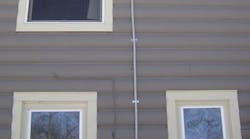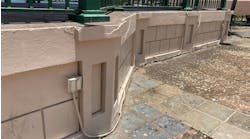How well do you know the Code? Think you can spot violations the original installer either ignored or couldn't identify? Here's your chance to moonlight as an electrical inspector and second-guess someone else's work from the safety of your living room or office. Brian, who has a knack for finding shoddy electrical work, did the dirty work and found this mess. Now it's your turn to identify the violation.
Find the Answer
Although it might be a little hard to see, the exposed conductors of the SE cable are too close to the window, which is a violation of the rules given in 230.9. This section states, "Service conductors installed as open conductors or multi-conductor cable without an overall outer jacket shall have a clearance of not less than 900 mm (3 ft) from windows that are designed to be opened, doors, porches, balconies, ladders, stairs, fire escapes, or similar locations." The exposed conductors on the side of this building are secured to the siding within 3 ft of the window.
The basic concept is to keep the open service conductors far enough away from the window to prevent someone from accidently, or, to a certain extent, intentionally coming in contact with them. The other locations identified (i.e., doors, porches, balconies, ladders, stairs, etc.) are also situations where the Code wants to prevent accidental or intentional contact. Contact with these conductors could result in electric shock or electrocution.
It's worth noting that this rule does not apply to the SE cable, itself, but rather only the exposed conductors. If the service conductors were "open" conductors or made up of a cable that does not have an overall jacketing, they would also be subject to the clearance given here. However, the SE cable is permitted to be closer than 3 ft, but the conductors that are uncovered must be at least 3 ft away.
While perhaps not as aesthetically pleasing as the installation shown here, the service cable could have been routed at an angle, away from the window, which would have provided the required clearance. This would have required the insulator (attachment point) to be relocated, but it would have done the job.
Alternatively, the cable could have continued up the side of the building until it was at a point where the exposed conductors were above the window. Either of these two options would have ensured compliance with the requirements of 230.9.




